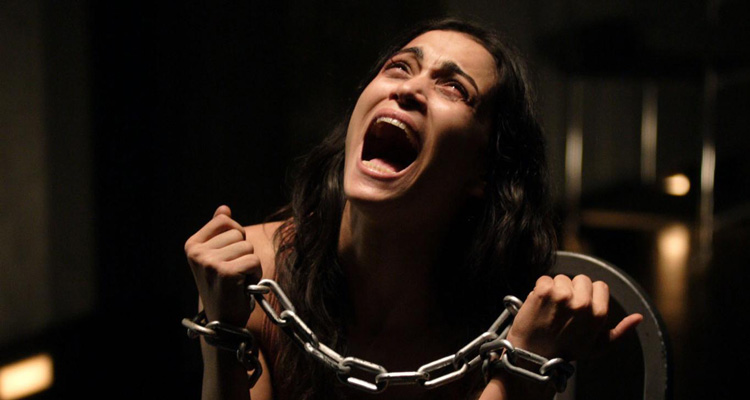
The art of cinema has always been the most controversial of expressions. Authors, painters, sculptors, poets, and musicians all freely craft their spirited mosaics without fear of being censored. Still a relatively young art form, it is held as common belief that there are some things that should never be allotted to the screen. Sex, murder, gore, and even something as small as coarse language suffer the woes of over-censorship.
Why? Good question. Some believe that consuming “vile media” and “sinful entertainment” could turn the most harmless of beings into the worst of crazed lunatics that feast solely on the virgin blood of infants. Could that be? Perhaps. But even the earliest of Neanderthals drew themselves some of the most violent and brutal cave paintings.
Though it is clear that the plague of the MPAA isn’t soon to cease, it is becoming more prominent for films to feature excessive content without being condemned for it. Thanks to the bravery of a few fearless directors, it is becoming increasingly accepted to flex one’s morbid curiosity. Today, we delve deep into the enthralling history of these insatiable provocateurs and the notorious scenes that pushed the envelope and shattered the boundaries of cinema as we know it. Here are the top ten torture scenes in cinema history.
(CAUTION: Spoilers Ahead!)
10. True Romance – The Sicilian Scene
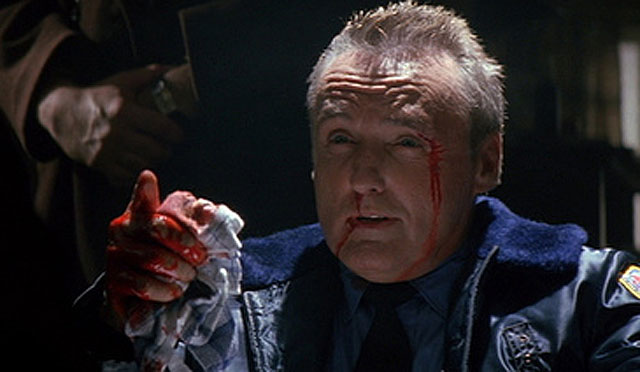
After fabled American folk singer Tom Waits finished reading the screenplay for Quentin Tarantino’s outstanding anti-caper tour de force “Reservoir Dogs” he complimented the script as being “pure poetry”. While that may have been a bit of an overstatement, Tarantino is genuinely the type of screenwriter that is gifted to the world of cinema only once in a million moons. He is able to write as easy as he can walk.
Combining sharp entertaining wit, cool quips, and fierce, gut-punchin’ monologues, Tarantino clasps the ungodly power of creating impossible, worthy prose. His track record of twelve spotless screenplays are as holy as the twelve apostles. Most average screenwriters would remove their left nut and sacrifice a new born puppy with it just to have written one measly line of throwaway Tarantino dialogue.
Hell, there’s a good chance that a few of them could be spotted digging through Tarantino’s trash basket like starved racoons in the middle of an aching night. But before Quentin was considered Hollywood’s boy wonder, he punctiliously penned what is maybe his most sterling scribe in the dusty, gloomy corridors of a rundown California garage; “True Romance”.
“True Romance” is a whimsically violent lovers on the run story that also serves as a loose biographical portrait of Tarantino’s own life pre-success. Focusing on the rambunctiously impulsive life of teenage pop-culture fanatic “Clarence Worley” (Christian Slater), the film energetically observes its thrill seeking protagonist’s daily driftings from attending double bill kung fu flicks on his birthday to hanging out in the shabby corners of bars and raving about the king himself; Elvis.
Possibilities and avenues seem infinite and endless, as they do in anyone’s youth, to Clarence until one faithful night when he intertwines lives with sweet as pie call girl “Alabama” (Patricia Arquette). The two wandering souls become instantly bonded to one another and spontaneously decide to get hitched.
What seems like a happy ending falls immediately sour when Clarence settles to kill Alabama’s ruthless pimp Drexl (born to screen by method shape-shifter Gary Oldman) and ends up accidentally swiping a suitcase full of angelic narcotics. From there the film accounts the pair’s turbulent run from law and outlaw akin and the eventual catastrophe of their undying adoration.
To give Tarantino all the credit for this magnum masterpiece would be practically a mortal sin. For the late criminally underrated director Tony Scott puppeteers the script more masterfully and delicately than Tarantino could have ever dreamed of. It’s true, Tarantino’s version could have been on par with Scott’s, but here it seems Scott captured something remarkably gritty and subtle. He allowed the stone cold sensational cast to play characters rather than caricatures.
A prime example is one of the film’s two torture scenes known as “The Sicilian Scene”. Christopher Walken perfectly personifies evil as a mob boss caught amidst a vendetta sort of mood while questioning Clarence’s father (played by Denis Hopper). Although Chris Walken is only on screen for a bare 10 minutes, he imperiously steals the entire show.
This is a torture scene where the torturer is scarier and more effective than the actual torture itself. Walken’s icy presence seeps through the screen and sends chills down the viewers spine as he plainly announces himself as the antichrist and throws answer inducing punches into Hopper’s steal mug. Within his black, soulless eyes, one can see they are not reviewing an actor playing a character. They are reviewing an actual demon unearthed from hell. A merciless demon that’s presences alone makes this torture sequence a terror for the ages.
For the small amount of blood and suffering, this scene surprisingly resonates due the award worthy performances of two of cinema’s most enigmatic and virtuoso thespians to ever grace the silver screen.
9. Only God Forgives – Chang’s Punishment
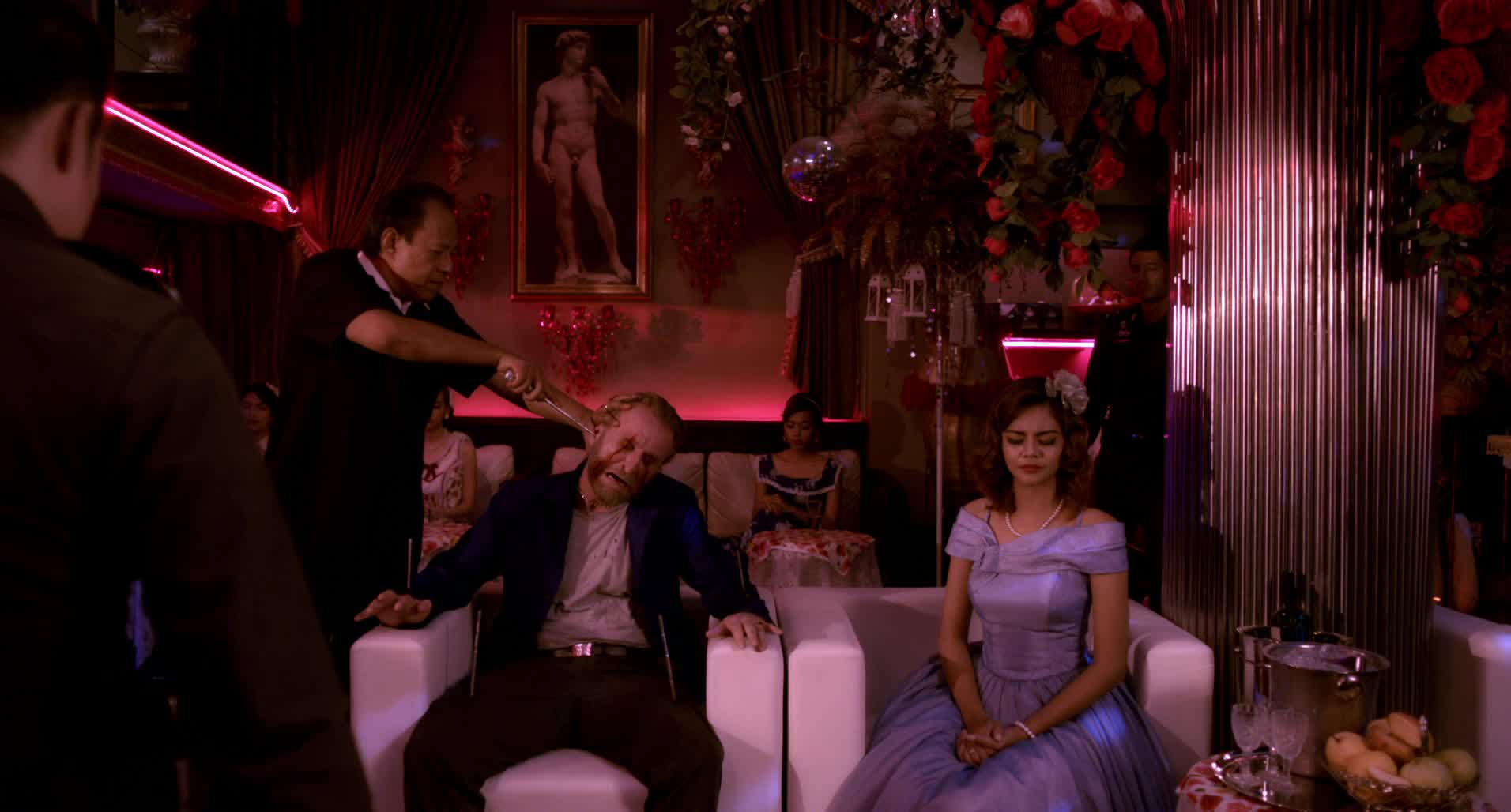
Danish avante-garde auteur Nicholas Winding Refn was furiously propelled into the American spotlight with his cool as ice heist thriller “Drive”. After winning best director at Cannes as well as the celluloid hearts of every cinephile, Refn was faced with the once in a lifetime choice of selling out to the machine or remaining under the radar as an art house savior and legend. With his spiritual follow up feature “Only God Forgives”, it was more than clear that he chose the latter.
Though the film was unfairly reviled by critics, “Only God Forgives” is rapidly becoming a cult phenomena. Featuring some of the most savage scenes ever conceived alongside some of the most tranquilly meditative beauty frames, the film is like descending reluctantly into a dreamy nightmare hellscape limbo where the worst of worst men and women are cursed to roam a gorgeous waste among one anothers’ putrid souls. Not exactly the feel good movie of the year, the picture attributes profound themes of spirituality, morality, family, and revenge. Beneath it all, lies something to be examined and admired through rewatches in years to come.
Out of the hour and half run time, there is about an hour of fetshized violence. The film eerily drifts from one disturbing act of human cruelty to the next like some twisted symphony of atrocity. Prostitutes being casually thrown around as punching bags, a young man receiving an unrelenting clobbering until he is no more than mince meat, wombs and chests being sliced and diced and dissected as if it be a social norm are among the galore of gore projected on screen. Many of which stand out, there is one particular sequence that ingrains deeply in the viewers mind like a bad acid flashback.
This scene, dubbed here as “Chang’s Punishment”, boasts an unforgiving angel of vengeance, known by the name of “Chang”, interrogating an Australian thug about the death of a working girl’s father. Setting the scene in a magnificently stunning, perfectly pink Thai karaoke club, Refn manipulates us into gaping in awe at the illustrious, flamboyant architecture and sweet, light music just before dropping us into wincing in cringe at the agony and suffering of a helpless suspect.
The cocky Aussie convict rests easy in a lavish chair enjoying the reposeful aura of the club when he is suddenly interrupted and questioned by police. When he refuses to give up information, the police bring Chang in for backup. Chang, not exactly known for his pacifist ways, begins his part in the interrogation by skipping right to the verdict and punishment.
His wrath opens by nonchalantly borrowing a set of hair pins from a bystander and stabbing them harshly through the guilty one’s arms, and into the arms of the chair. The man screams. Having his prey pinned right where he wants him, Chang takes a slow stroll about the place and finds himself an additional two sharp ornaments. He returns and pierces them into the wailing man’s legs to hold him further. Still not satisfied, he recoils himself to a nearby fruit bowl and removes from it his next tool: a small but sharp razor blade.
With it he slices the man’s eyes to blindness. After the man is pinned down like a rabid animal and viciously blinded, the horror is over, right? Nope. Chang finds himself an ice pick and slowly deafens the man by stabbing it deep into the softs of his ear drums. Trails of blood river from the man’s ears and eyes as he shrieks out in intolerable yelps of pain. It’s a tough one for the viewer to swallow, and even the most desensitized soldier might find trouble getting through it, but still it exists as one hell of an entertaining torture scene!
8. A Clockwork Orange – The Ludovico Treatment
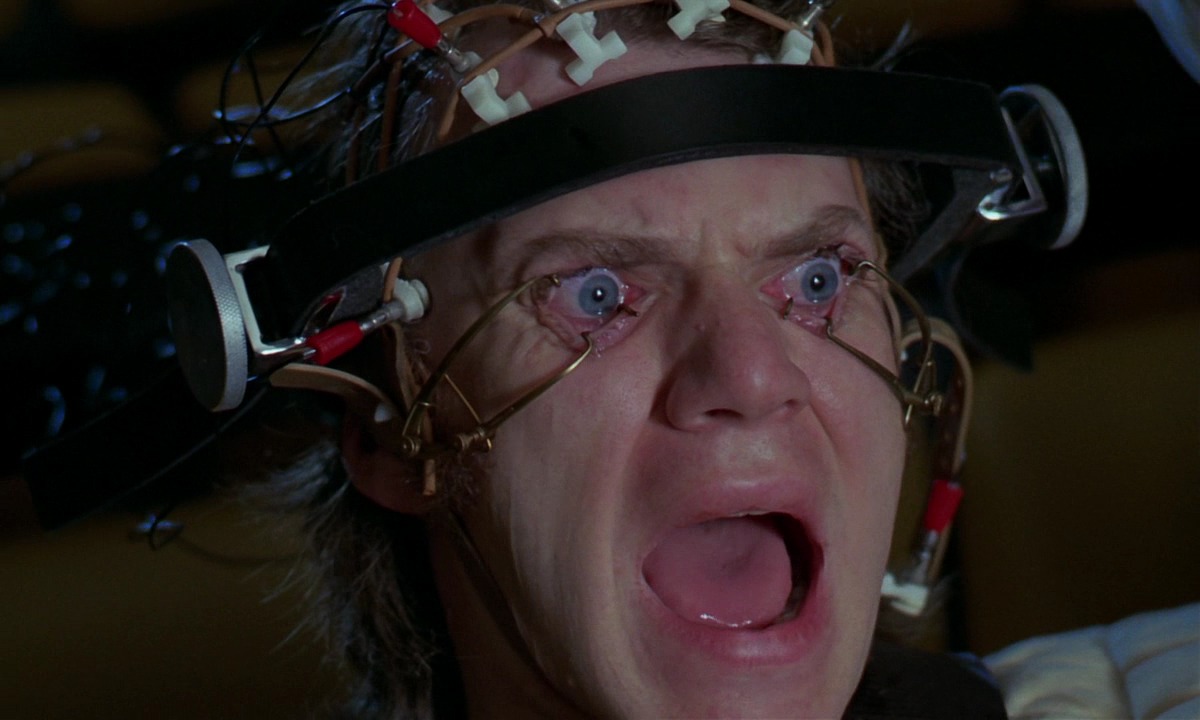
Four words: Singing. In. The. Rain. Four words that are eternally changed in one’s mind after witnessing the deviant madness of Stanley Kubrick’s “A Clockwork Orange”. Some call it social satire, others despise it as a glorification of sadistic mischief, “A Clockwork Orange” is a viewing experience like no other before or since. Like tumbling into a wicked vaudevillian horror show, the film sweeps us away to a dystopian world familiar yet foreign in which teenage street gangs rule the roads and citizens exist in their own isolated paranoia.
This is a film that, at the time, violently shook the preconceived notions of cinematic decency. It was scorned, burned, banned, and pulled from a mass of theaters for it’s unapologetic explicit nature. There are almost too many notoriously controversial scenes from this film that classify as “torture”. But one in particular, is so hauntingly unforgettable that even an indefinite amnesia couldn’t erase it.
Alex DeLarge is an average teenage sociopath who enjoys indulging himself and his little droogs in nightly spats of ultra-violence and forced in-out, in-out upon weepy young devotchkas. Though sometimes he just likes to sit back, relax, and toast a tall glass of Milk-Plus. Eventually his playful acts of delinquency catch up with him though, and he is arrested for murdering a wealthy cat-lady with a hefty piece of phallic art during a robbery gone wrong. This in turn leads to jail, and jail leads to an experimental treatment known as “The Ludovico Treatment”.
The Ludovico Treatment begins with a patient, in this case Alex, bound in a straight jacket and strapped to the confines of a chair within an empty movie house. Then, a halo of wired probes are placed upon the patients head for scientific monitoring and management of the process. Next the patient’s eyes are forced open with clamps that hold them from blinking and a montage of sadism begins projection before them on the screen.
It doesn’t sound so bad, except that after about a minute’s passing, the real treatment starts to kick in. The patient begins to feel a gut-wrenching sickness from which they cannot rid. All while a doctor keeps the patient’s pupils wet with eye drops. As if eye drops on their own aren’t torture enough!
This scene becomes particularly hard to watch due to the realistic nature of actor Malcom McDowell’s (Alex) reactions. He gags and screams and pleads for help. “STOP IT! STOP IT! PLEAAAASSSE!”, he begs. Perhaps because during the filming of the experiment, Kubrick prolonged the take for a time longer than he promised and old lucky Malcolm ended up actually scratching the surface of his cornea. Such is art…
7. Reservoir Dogs – The Infamous Ear
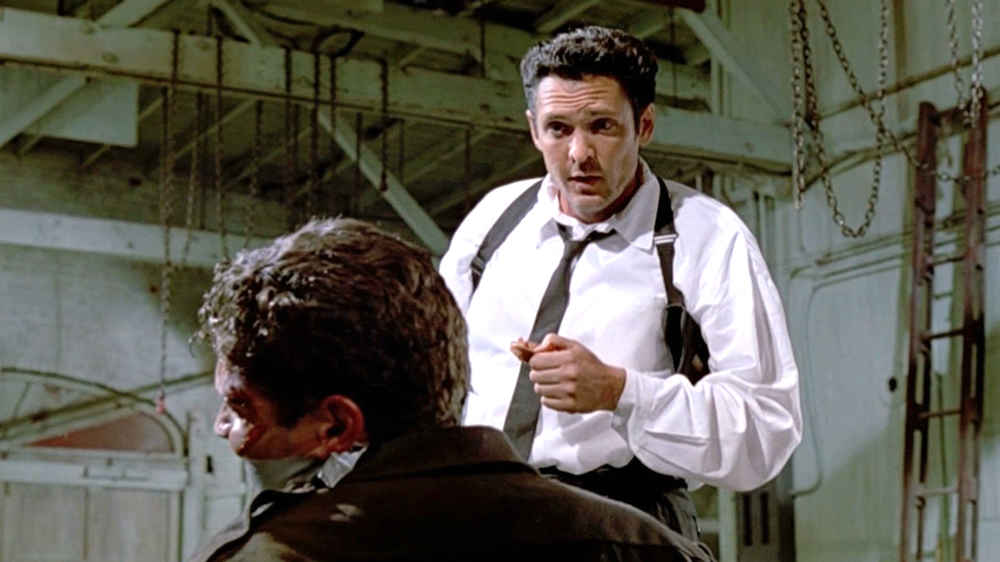
There’s never quite been a young talent to explode into prodigal indie stardom with as much ferocity and audacious style as Quentin Tarantino. His debut heist feature “Reservoir Dogs” just about measured on the Richter scale at the 1992 Sundance Film Festival.
Critics and audiences alike were so breath-taken by the scathing originality, quotable dialogue, and unpredictable narrative, that it was suggested that complementary inhalers be handed out before additional screenings to prevent sudden fits of astonished asthma (this part isn’t actually true, but people did pretty much lose their minds). One critic even compared the film’s impact to that of the first footage of a moving train. Everyone who saw it, left the theater with their jaws at their toes. They were spellbound.
The film was heavily talked about, not only for it’s incredibly fresh execution, but also for the extreme gore and violence it depicted with slick pleasure. Particularly a scene in which a character by the name of Mr. Blonde (portrayed as one of the coolest characters of all time by Micheal Madsen) physically interrogates a police officer for information about the identity of an undercover. What makes this sequence so horrifying is the way Mr. Blonde treats it so playfully.
Right away he dials in the upbeat tune “Stuck In The Middle With You” by the band “Stealers Wheel” casually on the radio. Then, with a shaver’s razor in hand, he proceeds to dance and sing along with the music without a care in his mind. Smiling. Laughing. Truly enjoying every moment of the anticipation. Tarantino heightens the ugly effect of the scene here by dollying the camera slowly past the duck-taped, blood blemished grimace of the struggling cop and it works to the utmost palm wetting suspense.
Soon, Mr. Blonde makes his move. He slices an ear clean off of the cop’s head. Oddly enough, Tarantino doesn’t show the actual amputation. Maybe that’s what makes it so disturbing after-all? Nonetheless, once the ear is removed, Mr. Blonde dangles it out and mocks the officer by speaking into the abstracted appendage gleefully.
As if that isn’t enough, he tosses the ear away and douses the cop in a gallon of gasoline. Intending to send him off into the void in a blaze of inglorious glory. The entire scene plays like a beautifully sadistic ballet recital. If you haven’t, by some astronomical anomaly, gotten the chance to check this one out. Do it. Right now.
6. Casino – Vice Grip

There’s nothing as thrilling as losing money. At least that’s what the casino sells you. Everyone who has been to the casino, knows that sinking feeling of comin’ in with a stack of Benjamins and leavin’ with their ghosts. But even so, there is something so mysteriously gravitating about the place.
It has an energy. An illustrious allure. Maybe it’s the carnival lights. Or the faint hope in the distance that says “You’re going to be a millionaire tonight, kid. This is your last night a bum!”. Or maybe it’s that intoxicating arcade sound of the slot machines spinning like game show wheels or the rattle of coins waterfalling like hail into the of empty beggar buckets. Whatever the case, the idea of gambling and taking risks makes for dandy entertainment.
When Martin Scorsese set out to make yet another operatic mafia epic, everyone thought it to be just a rehashing of the already perfect film “Goodfellas”. Upon release it was dismissed as an overlong inferior film to the one previous and quickly shelved as a no risk, no thrill film by its director. But overtime, the sprawling, three and a quarter hour, Vegas set, mob story has aged impeccably well and has risen to be as good, if not perhaps better, than its predecessor. Darker, grittier, and with far more intricate depth than “Goodfellas”, Casino is a flashy rise and fall fairytale set against the free range paradise of 1970’s Las Vegas.
Robert DeNiro, in one of his career bests, plays the no bullshit, gambling wiz, casino manager Sam “Ace” Rothstein whose singular goal is to oversee his establishment to the highest possible standards while at the same time reeling in as much money under the table as he can for himself and the mob. As with everything in the city of dreams, Rothstein’s scheme starts fiercely at an unstoppable streak and slowly descends and fizzles to nothing but shambles.
Most of his problems begin arising when loose cannon Nicky Santoro (played by the incomparable Joe Pecshi) is sent in as protection for Sam. Nicky, unlike Sam, sees Vegas as the lawless open plains of the Wild West and himself as a devil sold outlaw who rules it. He freely muscles club dealers, pilfers diamonds and royalties from mansions and gift shops, and murders in cold blood any soul who dares detest him. It becomes blatantly apparent that he doesn’t need the wealth nor does he care to protect Sam at all, he just gets off to the anarchy in his madness.
Possessing a fuse shorter than dynamite, Nicky often uses extreme methods in his punishments. In one such instance of pure, indulgent ire, Nicky places the head of an Irish gangster in the clasp of a tool shed vice grip (just after ice picking his balls mind you) and begins to squeeze. The man gargles on blood as Nicky jokes “I’m going to burst your head like a fucking watermelon!”.
With each turn of the vice’s wand, audible struggles and crunches can be heard. When at last the skull in the grip begins to fold and cave outwards, and an eyeball is just about pop, Nicky reveals a steak knife and does the guy a “fucking favor” by slicing his jugular wide open and letting his sins gush out. It’s remarkable that this scene made it into the R-rated cut of the film, with Martin Scorsese himself inserting the torture in mere hopes the censors would ask him to chop the scene and keep the rest.